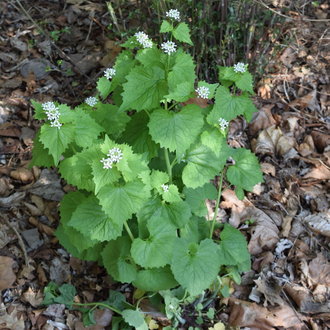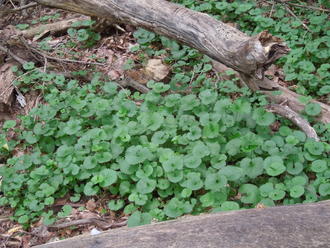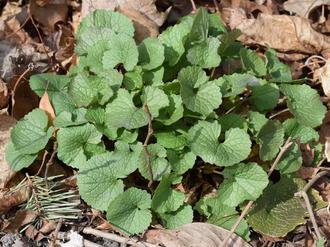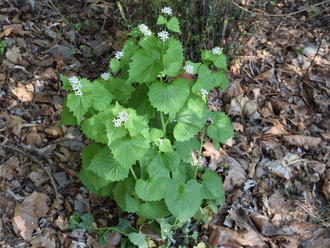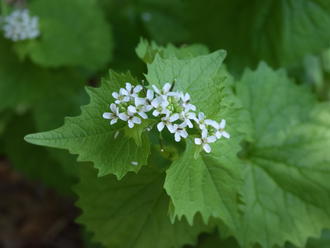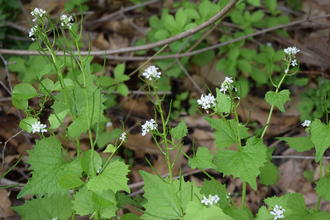Garlic Mustard (Alliaria petiolata (M. Bieb.) Cavara & Grande)
↑Summary
A biennial native to Europe, and one of the most damaging invasives in forests of eastern North America.
↑Range - Expand
| Legend | Color |
| Introduced | |
| Garden Persistent | |
| Introduced or Not Present |
This map is based on our research. We have checked its accuracy to Level 3 ecoregions. Although this plant occurs somewhere in each of these regions, it may only occur in a small part of some or all of them.
The "Garden Persistent" status in the Central Basin and Range reflects the fact that this species only survives in irrigated gardens there.
↑Habitat
In North America, found in a wide range of conditions, from areas that periodically flood to fairly dry soils, and lighting conditions from an open field to a closed forest canopy, although it grows best in light shade or partly-shaded habitats. Plants survive but have stunted growth on poorer and more compacted soils and drier sites. Intolerant of acidic soils. Mostly found in habitats that experience some sort of disturbance, whether natural or human-induced.
Found in deciduous woodlands, woodland borders and paths, gardens and suburbs, disturbed forests in urban and industrial areas, the understory of thickets, and shaded disturbed ground. Thrives in disturbed areas but also invades a wide range of natural forest types, including mature forests and other intact natural areas. Often colonizes gaps created by browsing by white-tailed deer.
Absent from conifer-dominated forests, possibly because of acidic soil.
Survival under different fire regimes is not well-studied. It does well in areas free of fire and may not thrive as much in fire-prone areas, but may also be able to survive fire to some degree by reseeding and/or resprouting from roots.
↑Life Cycle
Garlic mustard is primarily a biennial, occasionally growing as a winter annual.
Most seedlings germinate early in the spring, and grow as basal rosettes during their first year, with foliage usually persisting through the winter. Both the early germination of seedlings and persistence of foliage through the winter help this plant compete against other species. Mortality rate of seedlings is high; the seeds produce tiny plants that are initially sensitive to drought during the period of increased light before trees and shrubs leaf out.
In spring of the plant's second year, it grows upright and flowers. Flowers are self-fertile, but can also be cross-pollinated. Seed production is large, and seeds are often ejected several feet from their pods, but typically most seeds fall near the parent plant. Humans and deer may spread seed to new areas, as reflected by the fact that this species often spreads along paths initially.
Seeds require one and sometimes two seasons of cold dormancy before germination. However, seed banks are short-lived, and viability decreased markedly in multiple years, with smaller portions of seeds being viable for around 5 years.
We found no reports of vegetative reproduction. However, if flowering stems are cut or removed earlier in the season, before seed is mature, plants will usually resprout, bloom, and produce seed later. Unripe seeds can mature on detached stems.
↑Faunal Associations
The introduced cabbage white butterfly, Pieris rapae, is both attracted to the flower nectar, and eats this plant (among other cabbage-family plants) in its larval stage.
↑Control
Different scenarios require different control strategies, both based on the extent of the garlic mustard population, the habitat, and goals.
Small, relatively new populations can be easily controlled by manually pulling individual plants. It is easier to prevent garlic mustard's establishment on a site by pulling newly established plants in an area where no plants have gone to seed, than to remove an established population, as established populations will have seed in the seed bank.
For manual control, it is key to remove plants before they set seed. Seeds can mature on uprooted plants, so removal must happen before seeds form. The safest and lowest-effort approach to manual control is to uproot plants before they bloom. In this case, plants can usually be discarded and left to die in-place, with minimal risk of them re-rooting or successfully producing seed. Care must be taken to remove the root when uprooting, as plants can resprout and flower and produce seed if the stalk is broken off from the root. This is more likely to occur in hard, compacted soil or when the plants are growing in cracks in rock or pavement. Plants, however, cannot resprout from small root fragments, so as long as the central taproot is removed, plants will die.
Control of second-year (flowering) plants to prevent seed production is always top-priority, but if there are resources to also remove seedlings and first-year plants, their removal can speed both the removal of garlic mustard and the re-establishment of competing native plants.
Successfully eliminating this species typically requires at least 5 years of continuous effort, due to its persistence for about this time in the seed-bank, but significant reduction can happen in a shorter time-scale.
Large monocultures of the plant can be treated with post-emergent herbicides, or can be mowed after plants bolt but before they set seed in order to reduce seed production: mowed plants will resprout but seed production will be poor, and in some cases, well-time mowing can favor the establishment or growth of other vegetation.
Pre-emergent herbicides are not effective at controlling this species because its germination window is too long, and because they also will inhibit germination of native plants that would compete with it.
In general, hand-pulling is better for small, isolated infestations and scenarios where garlic mustard is competing with native plants, whereas mowing or herbicide is better for large monocultures where there are few other plants growing in with the garlic mustard.
↑Uses
Edible, and initially brought to North America as a food plant. The leaves taste like mustard greens with a distinct garlicky aroma, and are often more tender than most cultivated mustard greens. Tender young leaves can be eaten raw and older leaves cooked. Large volumes of leaves are sometimes made into pesto. Young plants growing in rich conditions in shade are usually most tender.
Not commercially cultivated, and primarily consumed by people who want to take advantage of this abundant plant and contribute to its removal.
↑Related Plants
This is the only species of its genus found in North America, but there are many species, both native and introduced, in the broader Brassicaceae family. This species has been classified in the Thlaspideae tribe, none of which are native to North America.
↑Notes
This species is often considered one of the most damaging invasive plants in North America, especially in the northeast. Unlike many invasive species, which are mostly limited to disturbed habitats, garlic mustard is particular threatening because of its ability to invade undisturbed habitats.
The lack of natural herbivores, parasites, and pathogens that affect this species in North America contributes to its dominance, while causing collapse of the food web as it supports fewer insect herbivores than the vegetation that it out-competes.
However, it also creates other cascading changes in ecosystems. Plants are allelopathic, inhibiting the growth of other plants. Some native plant species are able to adapt to this allelopathy within a few generations.
Its chemicals also affect fungi, including mycorrhizal fungi that are important in the cycling of energy and nutrients in ecosystems.
↑Links & External Resources
• Garlic Mustard | Fire Effects Information System (FEIS) (About This Site)
• Alliaria petiolata (Garlic Mustard) | Illinois Wildflowers (About This Site)
• Alliaria petiolata (Garlic Mustard) | USDA PLANTS Database (About This Site)
• Alliaria petiolata | Go Botany (About This Site)
• Alliaria petiolata | Biota of North America Project (BONAP) (About This Site)
• Alliaria petiolata | NatureServe Explorer (About This Site)
• Alliaria petiolata | Flora of North America (About This Site)
• Alliaria petiolata | Missouri Plants (About This Site)
• Garlic Mustard | Maryland Biodiversity Project (About This Site)
• Alliaria petiolata (Garlic Mustard) | Minnesota Wildflowers (About This Site)
• Alliaria petiolata (Bieberstein) Cavara & Grande (Garlic Mustard, Hedge Garlic) | Digital Atlas of the Virginia Flora (About This Site)



